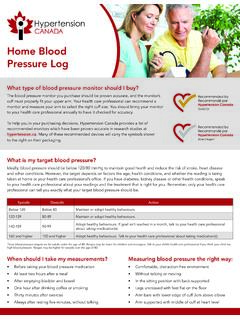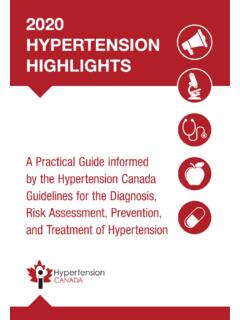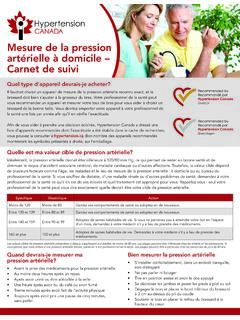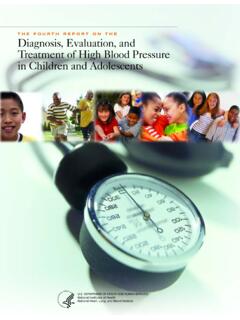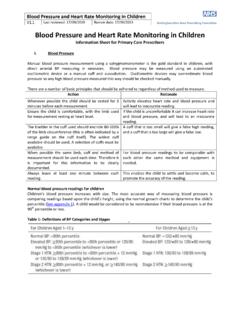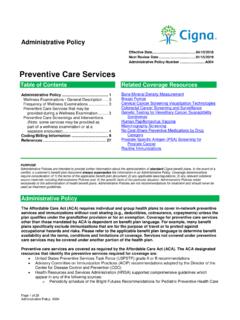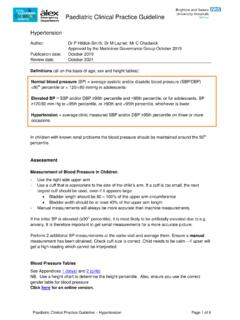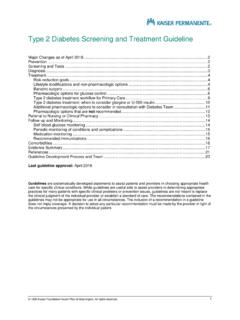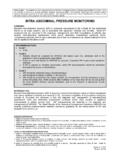Transcription of 2020 - 2022 HYPERTENSION HIGHLIGHTS
1 AA Practical Guide informed by the HYPERTENSION Canada Guidelines for the Prevention, Diagnosis, Risk Assessment, and Treatment of Hypertension2020 - 2022 HYPERTENSIONHIGHLIGHTS1 Arm bare and supported Use a cuff size appropriate for your arm Middle of the cuff at heart level Lower edge of cuff 3 cm above elbow crease Sitting position Back supported Do not talk or move before or during the measurement Legs uncrossed Feet flat on the floorAccurate diagnosis begins with accurate measurement: blood PRESSUREMEASUREMENT TECHNIQUE HYPERTENSION 2020-22: HIGHLIGHTSThe HYPERTENSION Canada Guidelines are the nation s clinical practice guidelines for the management of HYPERTENSION . Developed by an expert volunteer network, the Guidelines are evidence-based, rigorously reviewed, and updated regularly to keep Canada s health care professionals informed of best-practices in HYPERTENSION booklet HIGHLIGHTS the most critical and widely relevant aspects of the HYPERTENSION Canada Guidelines.
2 Beginning with proper measurement techniques for diagnosis and advancing through treatment and follow up, this booklet serves as a practical guide for health care full Guidelines with supporting evidence, which also address complex specialty issues, can be accessed at , and have been published at: Rabi, Doreen M. et al. HYPERTENSION Canada s 2020 Comprehensive Guidelines for the Prevention, Diagnosis, Risk Assessment, and Treatment of HYPERTENSION in Adults and Children. Can J Cardiol. 2020;36(5) Practical Guide informed by the HYPERTENSION Canada Guidelines for the Diagnosis, Risk Assessment, Prevention, and Treatment of Hypertension2020 - 2022 HYPERTENSIONHIGHLIGHTS23 WH AT S N E W? The use of a low-dose acetylsalicylic acid (ASA) for primary prevention of cardiovascular disease is no longer recommended in people with HYPERTENSION in the absence of manifest vascular disease. The possibility of pregnancy should be considered in all women of reproductive age with a new diagnosis of HYPERTENSION , and during follow-up visits.
3 Determination of pregnancy is important in treatment of women of reproductive age as some medications ( , ACE inhibitors/angiotensin receptor blockers) are contraindicated in pregnancy. Practitioners should offer preconception counselling and check for possible pregnancy at regular intervals for women of reproductive age being managed for HYPERTENSION . The recommended measurement frequency for ambulatory blood pressure monitoring (ABPM) is 20- to 30-minute intervals throughout the day and night. It is no longer recommended to have different intervals for nocturnal and daytime measurements. Resistant HYPERTENSION is defined as blood pressure above target despite three or more blood pressure lowering drugs at optimal doses, preferably including a diuretic (and usually a renin-angiotensin-aldosterone system blocker and a calcium channel blocker).WHAT S STILL REALLY IMPORTANT? Out-of-office measurements are essential to rule out white coat HYPERTENSION in patients with or without diabetes, and to diagnose masked HYPERTENSION , when suspected.
4 A risk-based approach should be followed to identify appropriate treatment thresholds and targets. When possible, the use of a single-pill combination (SPC) should be considered to improve treatment efficacy, adherence and tolerability. Follow-up visits are an essential part of management and frequency should reflect individual clinical situations (see p. 24).45 PATIEN T E VA LUATIO NI. MEASUREMENTThe use of standardized measurement techniques and validated equipment is recommended for all blood pressure (BP) Office blood pressure is performed using an automated device that can take a series of oscillometric measurements without the provider or others present. The patient is left unattended in a private area while 3-6 oscillometric, consecutive readings are method of in-office blood pressure Measurement is performed using an upper arm device with the provider in the room. Oscillometric or electronic devices are preferred when using this method.
5 Auscultatory mercury or aneroid devices are an alternative if an electronic device is not blood pressure Monitoring requires the use of a validated oscillometric device which must be worn by the patient for a 24-hour period, with measurements taken at 20- to 30-minute out-of-office method for diagnosisHBPMHome blood pressure Monitoring is a self-monitoring method which requires the patient to measure their blood pressure twice in the morning and evening for 7 you measuring correctly?Accurate diagnosis begins with accurate measurement. Evidence demonstrates that routine manual BP readings obtained in clinical practice are, on average, higher than when validated automated measurement devices are used. Inaccuracies in BP measurement can have clinical consequences such as incorrect diagnosis, misclassification of cardiovascular risk, or improper dosage of antihypertensive using electronic upper arm devices is preferred over auscultation. If electronic devices are unavailable, be sure to implement the recommended standardized technique for OBPM.
6 Is arm size an issue?In patients with very large arm circumference, when standard upper arm measurement methods cannot be used, validated wrist devices (utilized with arm and wrist supported at heart level) may be used for blood pressure is important to note that wrist devices are for estimation and not recommended for exact TECHNIQUE FOR AUTOMATED OFFICE blood pressure (AOBP) Measurements should be taken in a sitting position with the back supported using a validated device known to be accurate. BP should be taken in both arms on at least one visit and if one arm has a consistently higher pressure , that arm should be used for BP measurement and interpretation. A cuff with an appropriate bladder size for the arm should be chosen: bladder width should be close to 40% of the arm circumference and length should cover 80-100% of the arm circumference. The arm should be bare, supported, and kept at heart level. The lower edge of the cuff should sit 3 cm above the elbow crease with the bladder centred over the brachial artery.
7 The patient s legs should be uncrossed with feet flat on the floor. There should be no talking and the room should be quiet. The device should be set to take measures at 1-to 2-minute intervals. The first measurement should be taken to verify the cuff position and validity of the measurement. The patient should be left alone after the first measurement while the device automatically takes subsequent readings. The mean BP as displayed on the electronic device should be recorded, as well as the arm used and whether the patient was supine, sitting or Threshold for diagnosis:A mean SBP 135 mmHg or DBP 85 TECHNIQUE FOR OFFICE blood pressure MEASUREMENT (OBPM) Measurement using validated electronic (oscillometric) upper arm devices is preferred over auscultation. Measurements should be taken in a sitting position with a device known to be accurate. BP should be taken in both arms on at least one visit and if one arm has a consistently higher pressure , that arm should be used for BP measurement and interpretation.
8 If an electronic device is not available, a recently calibrated aneroid device or sphygmomanometer can be used and ensure the device is clearly visible at eye level. A cuff with an appropriate bladder size for the arm should be chosen: bladder width should be close to 40% of the arm circumference and length should cover 80-100% of the arm circumference. The arm should be bare, supported and kept at heart level. The lower edge of the cuff should sit 3 cm above the elbow crease with the bladder centred over the brachial artery. The patient should rest comfortably for 5 minutes prior to the measurement in the seated position with their back supported. The patient s legs should be uncrossed with feet flat on the floor. There should be no talking and the room should be quiet. The first reading should be discarded and the latter two threshold for diagnosis in the absence of compelling indications:A mean SBP 140 mmHg and/or DBP 90 for diagnosis in Diabetes:A mean SBP 130 mmHg and/or DBP 80 note:Record BP to the closest 2 mmHg on the sphygmomanometer, as well as the arm used and whether the patient was supine, sitting or standing.
9 Record the heart vs. StandingThe seated BP is used to determine and monitor treatment standing BP is used to examine for postural hypotension, which may modify About Auscultation? Increase pressure rapidly to 30 mmHg above the level at which the radial pulse is extinguished. Place the bell or diaphragm of the stethoscope gently and steadily over the brachial artery. Open the control valve so that the rate of deflation of the cuff is approximately 2 mmHg per heart beat. The systolic level is the first appearance of a clear tapping sound (phase I Korotkoff). The diastolic level is the point at which the sounds disappear (phase V Korotkoff). In the case of arrhythmia, additional readings with auscultation may be required to estimate the mean systolic and diastolic pressure . Isolated extra beats should be ignored. Note the rhythm and pulse :If Korotkoff sounds continue as the level approaches 0 mmHg, listen for when the sound becomes muffled to indicate the diastolic the cuff partially inflated for too long will make sounds difficult to hear.
10 Leave 1 minute between readings for optimal results. 89 HOME blood pressure MONITORING (HBPM)Home blood pressure monitoring (HBPM) can be used in the diagnosis of HYPERTENSION , and monitoring on a regular basis should be considered for all hypertensive patients and particularly those with: Inadequately controlled HYPERTENSION Diabetes mellitus Chronic kidney disease Suspected non-adherence Demonstrated or suspected white coat effect BP controlled in the office but not at home (masked HYPERTENSION )If white coat or masked HYPERTENSION is suggested by HBPM, it should be confirmed by repeat HBPM or ABPM before treatment decisions are Home SeriesWhite coat or sustained HYPERTENSION values should be based on duplicate measures, morning and evening for seven days. First day values should be the ResultsBlood pressure logs are available for health care professionals to use with their patients at BP threshold for diagnosis:SBP >135 mmHg or DBP >85 mmHg should be considered elevated and associated with increased overall mortality year, with your health care professional, review the technique for measuring your My target blood pressure at home is less than:I use my: Left Armsystolicdiastolic/mmHGDateTimeComment sHeart Rate(beats/min)BP Reading #1BP Reading #2 SystolicDiastolicSystolicDiastolicJune 15 Sample Morning8:00 at 9 Evening8:00 1 EveningDay 2 EveningDay 3 EveningDay 4 EveningDay 5 EveningDay 6 EveningDay 7 EveningAverage day 2 to day 7 What type of blood pressure monitor should I buy?
